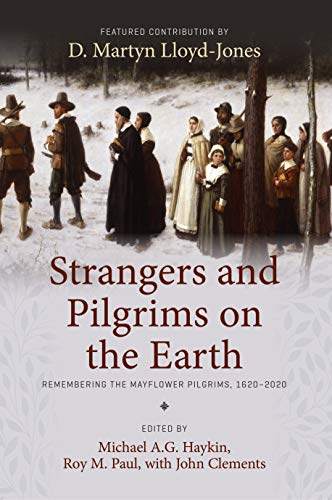A Book Review from Books At a Glance
by Gary Steward
Finding a book on the Mayflower Pilgrims that is generally appreciative is difficult to do. Many narratives of European trans-Atlantic crossings and colonization are filled with implicit charges of bigotry and greed. This book stands out in that its chapters were written by individuals who appreciate the religious zeal and piety of the Pilgrims and who share their Protestant convictions.
As an edited work, the volume eclectically treats of a variety different personalities and topics connected with the Mayflower Pilgrims. The book begins with an overview and reflection on the Pilgrims by Martyn Lloyd-Jones. This chapter was first presented as an address at a meeting of the British Evangelical Council in 1970, and its appearance in this volume is a treat for those who have enjoyed Lloyd-Jones’s other published lectures and addresses. In keeping with his other calls for evangelical separation, Lloyd-Jones used the Pilgrims’ example to call the evangelicals of his own day out of compromising ecclesiastical arrangements.
After the opening overview by Lloyd-Jones, the book proceeds to give a number of biographical chapters on key figures connected with the Pilgrim migration. Jonathan Piesse and Adrian Gray contribute chapters on John Robinson’s life, teaching, and historical setting. Michael Haykin writes on William Bridge, Tom Nettles writes on Francis Johnson, and Gary Brady writes on Robert Browne. All of these chapters are written at an academic level and are filled with many specific and interesting details. Noted historian of New England, Francis Bremer, contributes a brief sketch of some of the many sufferings that the Pilgrims endured in their ocean crossing. These historical chapters provide a wealth of well-researched material.
Other chapters explore the legacy and significance of the Pilgrims for the development of congregationalism, religious liberty, and the American political experience. Other chapters touch on the Pilgrims’ interaction with Native Americans and the experience of women in the Plymouth colony. When it comes to analysis of the Pilgrims, the authors of the book leave the reader with a sense of appreciation for the piety and the sacrifices made by the Pilgrims, but there remains a lack of clarity, however, in the book’s overall assessment of the Pilgrims’ contribution to later developments in America. Jason Edwin Dees praises the Mayflower Compact, for example, as the “document that laid the foundation for the kind of democratic constitutional government that America enjoys today. Its principles are clear in both the Declaration of Independence and the Constitution of the United States” (188).
Ryan Rindels, on the other hand, characterizes this kind of thinking as mythical, crediting John Quincy Adams, James Madison, and Daniel Webster with first popularizing such incorrect ideas in the nineteenth century. According to Rindels, “the Pilgrim Fathers would likely have judged the Declaration’s claim that men possess ‘the right to life, liberty, and the pursuit of happiness’ as incomplete, if not uncomfortably hedonistic, more akin to Epicurus than to the apostle Paul” (251). On another issue, Andrew Ballitch argues that the Pilgrims “planted seeds for a society of religious pluralism, true religious liberty,” (169) while Rindels argues that that the Pilgrim understanding of liberty was simply “the freedom to establish a pristine visible church” and that this vision was “inconceivable in a pluralistic society” (251).
The slightly discordant notes of analysis made by the contributors to this volume illustrate the difficulty of assessing a particular group’s “legacy” and “impact” upon the modern world. The contribution of the Pilgrims has been, and will remain, a bit elusive in our understanding of the Western world. This book is a welcome contribution to the ongoing discussion of the Pilgrims, but further analysis is needed for the “complicated legacy” that they left behind (242). Even so, few works explore the theology of those connected with the Mayflower Pilgrims like this one, and the book, therefore, is commendable.
Gary Steward
Assistant Professor of History, Colorado Christian University
